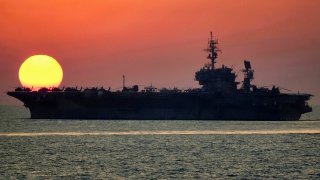The U.S. Navy Sold Aircraft Carrier USS Kitty Hawk for Just 1 Cent
The USS Kitty Hawk, a historic U.S. Navy aircraft carrier introduced in 1961, was sold for a symbolic one-cent after decades of service.
Summary: The USS Kitty Hawk, a historic U.S. Navy aircraft carrier introduced in 1961, was sold for a symbolic one-cent after decades of service.
-As the lead ship of the Kitty Hawk class, it represented an evolution from the earlier Forrestal class with improvements like better elevator placement for more efficient aircraft operations.
-Despite these enhancements and a costly overhaul in the 1980s, the Kitty Hawk, like its sister ship USS John F. Kennedy, was decommissioned and sold for scrap at a minimal price, highlighting the transient value of such massive naval investments once they reach the end of their service lives.
The USS Kitty Hawk: From Aircraft Carrier Naval Icon to One-Cent Scrap
The USS Kitty Hawk was built in 1961 for $264 million – or $2.5 billion in 2021 currency. But when time came to scrap the Kitty Hawk, she was sold for a mere fraction of her purchase price. Actually, she was sold for the lowest possible figure – one cent.
“USS Kitty Hawk today started her final voyage from Bremerton to a scrapyard in Texas,” the U.S. Naval Institute tweeted in 2022. “The Kitty Hawk was sold to the scrap company for the bargain price of 1 cent. For another penny, the company also got USS John F. Kennedy.”
Not a bad deal.
Remembering the Kitty Hawk
The USS Kitty Hawk was the lead ship in the Kitty Hawk class, which offered the U.S. Navy a slew of moderate upgrades from the preceding Forrestal class. Namely, the Kitty Hawk featured a longer deck and more appropriately placed elevators, allowing for improved operational efficiency and easier aircraft handling.
The class consisted of three vessels and was introduced in the early 1960s. Before being sold and scrapped, the class would see extensive use and would undergo an expensive overhaul in the 1980s. Despite an extensive service record (the USS Kitty Hawk served for five decades), the Kitty Hawk name is not synonymous with U.S. aircraft carriers. Most people think first of the Ford, Nimitz, or Enterprise. The name Kitty Hawk, meanwhile, is associated almost strictly with the Wright Brothers.
Yet the Kitty Hawk was an important class of carriers.
Incremental Improvements for Aircraft Carriers
The Navy’s newest class of carrier, the Ford, offers game-changing upgrades. Innovations like the Electromagnetic Aircraft Launch System and Advanced Arresting Gear greatly enhance the vessel’s sortie generation rate. The Kitty Hawk’s upgrades were far more modest. The class was an incremental improvement over its predecessor, the Forrestal class.
Four Forrestal carriers were built in the 1950s. The class was the first to feature deck-edge elevators, angled decks, and high tonnage, but the vessels had some very obvious shortcomings. The elevators were poorly placed, sitting in the launching and landing path of the waist catapults and complicating flight operations.
The Navy designed the Kitty Hawk with improved elevator placement. Two of the elevators were placed forward of the island and one after, with one elevator on the portside stern. The elevator placements proved more functional and permitted jets to launch and land more readily – thus improving the carrier’s sortie generation rate.
In the late 1980s, the ships were upgraded under a Service Life Extension Program that poured $785 million into the Kitty Hawk and $800 million into the Constellation. Despite all the work and investment that went into the vessel, after its retirement the Kitty Hawk was sold for just one penny.
About the Author: Harrison Kass
Harrison Kass is a defense and national security writer with over 1,300 total pieces on issues involving global affairs. An attorney, pilot, guitarist, and minor pro hockey player, Harrison joined the US Air Force as a Pilot Trainee but was medically discharged. Harrison holds a BA from Lake Forest College, a JD from the University of Oregon, and an MA from New York University. Harrison listens to Dokken.


